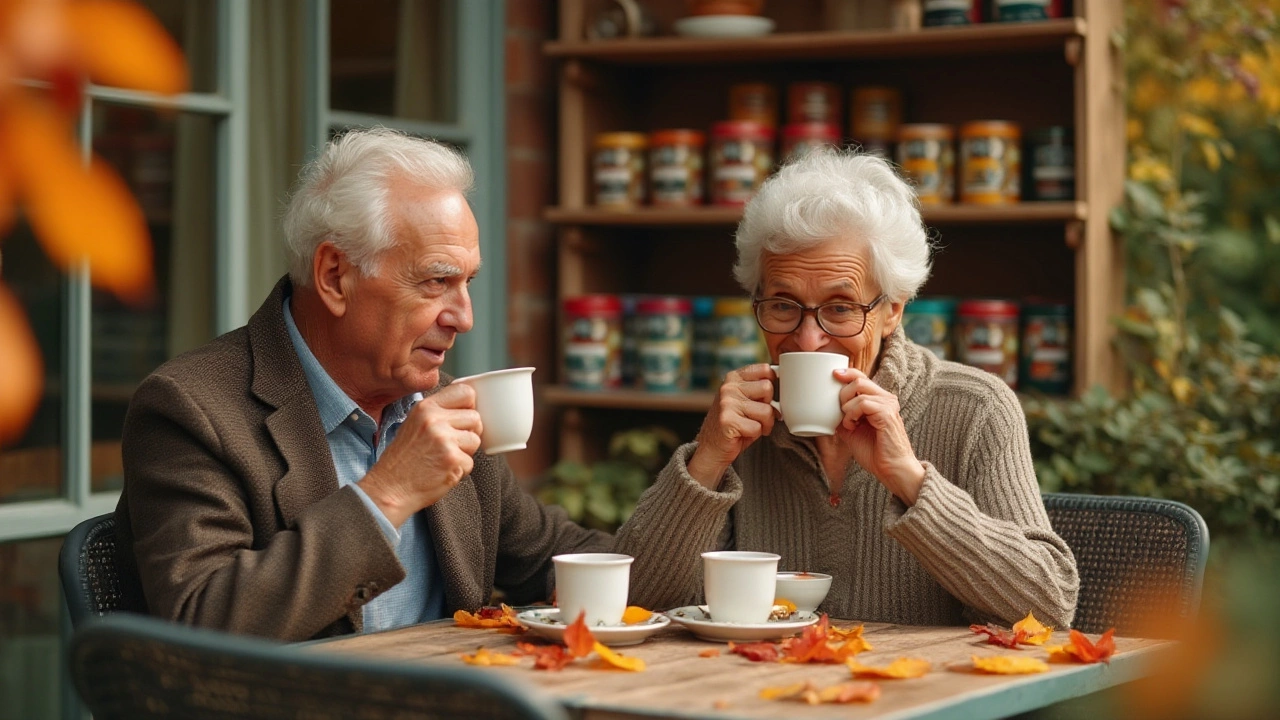Have you ever poured yourself a cup of your favorite tea, only to realize it no longer brings the joy it once did? You're not alone in this curious phenomenon. Taste can change for a variety of reasons, many of which might surprise you.
Our taste buds and sensory perceptions aren't static; they evolve over time, influenced by various factors in our lives. Whether it's a simple change in health, the impact of stress, or even the foods we now consume, these can all play a role in altering how we experience the flavors we once cherished.
This article delves into the reasons behind these shifts and offers insights and tips to help you rekindle your appreciation for tea. By understanding both the science and the personal elements of taste perception, you can open your senses to new experiences and find pleasure in the world of tea once more.
- Understanding Changes in Taste Perception
- Physical and Psychological Factors
- Diet and Lifestyle Influences
- Exploring New Tea Varieties
- Mindful Tea Tasting Techniques
- Renewed Appreciation for Subtle Flavors
Understanding Changes in Taste Perception
Taste perception is a fascinating phenomenon, deeply rooted in both biological and psychological processes that make it uniquely personal. One plausible reason for changes in how we experience the taste of tea lies in the very biology of our taste receptors. These receptors, specialized cells found on our taste buds, are responsible for detecting the five basic tastes. Much like the cells in our skin, taste receptors have a limited lifespan and regenerate approximately every two weeks, but this renewal process can slow with age or due to other factors, potentially altering one's perception of taste.
Aside from age, factors like health conditions can significantly affect taste. For instance, conditions such as zinc deficiency or various endocrine disorders can dull our ability to taste. Interestingly enough, psychological factors also weave their influence into our sensory world. Stress, anxiety, and even emotional states can alter how flavors are perceived. It's not uncommon for a cup of tea, sipped in a state of relaxation, to taste markedly different than when consumed during a stressful moment.
Notably, our sensory perception is not isolated to just taste but is a composite experience influenced by smell, sight, and texture. These senses work in harmony to create the overall flavor profile of anything we consume. Changes in any of these senses, for instance, a lingering cold affecting our sense of smell, can significantly alter the flavor of a tea that once delighted us. Recent studies have highlighted that over 80% of what we perceive as taste is in fact odor, indicating just how crucial our sense of smell is to enjoying a full flavor experience.
Environmental influences also play a quite overlooked role in shaping our taste preferences. Regular exposure to strong flavors, especially those that are highly processed or laden with artificial additives, can desensitize taste buds over time, making subtle flavors in a delicate white tea less noticeable. This notion of adjusted baseline taste sensation can make one's previous favorite blends seem bland or lackluster in comparison to bolder, more flavorful treats.
"Our sense of taste is a dynamic tapestry, constantly woven through the threads of biology, psychology, and environment." - Dr. Christine Jones, a renowned sensory scientist.
So what should you do if your beloved tea doesn’t taste quite right anymore? Experts suggest that exploring and experimenting with different types, even venturing into less familiar teas, can refresh your palate. Activities like flavor journals where you document what you taste can help reconnect you with the joys of tea appreciation, and bring that once-fleeting enjoyment back to life.
Physical and Psychological Factors
Taste perception is a fascinating and complex field that bridges both the physical and psychological realms. It is influenced by a variety of factors, each of which can significantly alter how we perceive and enjoy our favorite beverages, including tea. Physically, our taste buds undergo changes as we age. The number of taste buds generally decreases, and the remaining ones become less sensitive over time. This can subtly but profoundly affect the flavors we detect in familiar foods and drinks. Conditions like allergies or colds can temporarily dampen our sense of taste and smell, limiting our ability to truly enjoy the nuances of tea.
On the other hand, psychological elements also play a huge role in taste perception. Stress and emotional states can impact how we perceive flavors. When stressed, the body releases cortisol, which can dull the senses, including taste. This biological response can alter our experience with tea, making it seem bland or unappealing. Additionally, our expectations also shape our taste experience. For instance, if we habitually drink a luxury tea expecting a superior flavor, any deviation can be disappointing. A sense of routine can lead to an emotional detachment from once-loved aromas and flavors.
"Taste is not solely a function of what our tongue tells us," notes Dr. Julie Mennella of the Monell Chemical Senses Center. "It involves the interplay between our sensory experiences and our experiences in life." This quote encapsulates the interesting interplay between the sensory and the psychological which defines our perception of taste. Understanding these dimensions can aid in re-evaluating how we engage with tea.Another critical factor is our past experiences which shape our psychological response to taste. If you have fond memories of sipping chamomile tea with your grandmother, the flavor can bring a comforting feeling. Conversely, if you've had an unpleasant experience, it could sour the taste of even the finest tea. Consider trying teas during moments of calm and openness. Be mindful of the aromas and subtle notes, and see how they engage not just your taste buds but also your emotions. Sometimes, revisiting tea tasting with fresh perspectives can renew your appreciation.

Diet and Lifestyle Influences
The foods and beverages we consume regularly can profoundly affect our body's biology, including how we perceive flavors. Diets high in sugar and salt can significantly alter the way our taste buds function, often desensitizing them to more delicate flavors like those found in tea. Over time, the constant bombardment of intense flavors can cause a subtle shift in what our tongues perceive as tasty or bland. When the diet swings towards processed foods, we might not even realize how much of our natural taste perception is being overshadowed by these strong artificial flavors.
Moreover, certain dietary choices, such as consuming excessive caffeine or alcohol, can also dull taste receptors. Especially for tea drinkers, if your daily caffeine intake leans more towards coffee or energy drinks, your taste buds may unconsciously compare tea's subtle flavors to these stronger profiles. It's a bit like listening to a whisper after blasting your ears with loud music; you need time to adjust before you can appreciate the nuances again. Dietary balance, which includes a variety of fresh and whole foods, helps maintain the natural sensitivity of taste without overstimulation.
Lifestyle factors are equally important. Stress, for instance, can throw off your sense of taste. When under pressure, the body redirects energy to essential functions, which may reduce the acuity of your taste perception. Anecdotal experiences even suggest that during stressful times, people report coffee and tea tasting different. What you eat isn't the only thing that affects taste; how you live your life plays a major role too.
Did you know that regular exercise might enhance your sense of taste? Studies show that engaging in physical activities can increase blood flow, including to the tongue, potentially sharpening the senses. Exercise also promotes better mental health, reducing stress and its dulling effect on taste. Enjoying tea post-exercise might bring out nuances you hadn't noticed before. On the contrary, sedentary lifestyles might dull the vibrancy of flavors, subtly impacting your enjoyment of delicate teas over time.
It's also necessary to consider how specific conditions or medications can play a role. Certain medications, like those for high blood pressure or depression, often list taste alteration as a side effect. Thus, your changing tea experience might be linked more to prescriptions than palate choice. If you've been experiencing significant shifts in flavor perception, it could be worth discussing with a healthcare professional to explore whether lifestyle changes or medical factors could be influencing this.
Ultimately, to fully appreciate the tea experience again, you might need to make some conscious adjustments. By embracing a balanced diet, staying mindful of stressors, and possibly engaging in regular physical activities, you could find that tea becomes enjoyable again. Taking a step back from the cacophony of heavily flavored products and allowing your taste buds to reset might just bring back the once-familiar comfort of a well-brewed cup.
Exploring New Tea Varieties
The world of tea is vast and rich, offering a myriad of flavors, aromas, and experiences just waiting to be discovered. As you embark on a journey to reignite your passion for tea, consider stepping out of your comfort zone and exploring new varieties. This exploration not only adds excitement but also helps in understanding why your taste preferences might have shifted.
One excellent way to discover teas you haven't tried before is by opting for those from different regions or those that use unique processing techniques. For instance, teas like Pu-erh, originating from China's Yunnan province, offer a completely distinct taste profile due to their fermentation process. Each sip takes you through a historical journey, reflecting the soil and environment they grew in, something that could rekindle your enthusiasm for tea.
Not Just Black, Green, or Oolong
While black, green, and oolong teas are the most popular, there are several lesser-known types that could surprise your palate. For example, white teas are minimally processed and offer a delicate aroma and flavor that's quite distinct from what many of us are used to. The taste is subtle, hinting at a sweetness and floral note that might appeal to those who found stronger teas overwhelming. Similarly, herbal teas, although technically not teas, provide a plethora of flavors, from the fruity tang of hibiscus to the soothing scent of chamomile, broadening the tea experience considerably.Speaking of aroma, it's an often underestimated aspect of tea tasting. Different varietals offer varying scents that can evoke memories or emotions, adding a layer of depth to your tea experience. A rich, earthy aroma might remind you of autumn walks through the woods, while a light, floral scent could evoke a blooming garden in spring. Engaging with tea not just with taste but with other senses can significantly alter your perception, making you appreciate it anew.
A delightful way to explore new tea varieties is by participating in tea appreciation sessions or workshops. These events often provide an array of different teas, and experts guide you on how to properly taste and evaluate them. This setting can be much more enlightening as you get to share your thoughts and impressions with others who are similarly interested, or even those who have fall out of love with tea and looking to rekindle that affection. You might stumble upon a variety that resonates with you and helps restore your appreciation for tea.
"Tea is the magic key to the vault where my brain is kept," said Frances Hardinge, illustrating how each cup of tea unlocks a different set of thoughts and ideas, much like exploring new varieties can unlock new flavors and sensations.Starting with tea blends can also be beneficial. Companies often mix traditional teas with herbs, spices, and fruit, offering innovative blends that can be both refreshing and interesting. Imagine a combination of green tea with mint and rose petals; it's a completely different experience that can transform your perception of what tea can be.
In summary, the adventure of discovering new tea varieties is endless. It's not merely about finding something new but re-educating your taste buds and involving all your senses in the experience. The journey includes traveling through different cultures, flavors, and memories, each cup telling a story, waiting for you to listen, sip after sip. By immersing yourself in this journey, you might just find the new flavor that reignites your love for tea.

Mindful Tea Tasting Techniques
Engaging in mindful tea tasting is not just about the sensory experience but also about creating a calm and focused environment where one can appreciate the intricate details of tea, right from the first sip to the lingering aftertaste. The act of drinking tea becomes almost ceremonial, transforming what once was a routine habit into a sensory delight. To begin, it's crucial to set the scene. Choose a quiet place free from distractions, as this helps in tuning into each layer of flavor your chosen tea has to offer. This is your time to be present.
One effective approach is to start with your senses. Take a moment to observe the color of the brewed tea, noticing the nuances of its hue, which can tell you a lot about its character before you even take a sip. As you bring the cup closer, inhale deeply yet gently, allowing your nose to pick up the aroma, which often preludes the taste. Engaging all your senses prepares your mind to fully appreciate the tea experience. It's been suggested that aroma plays a significant role, as reported by the Tea Association of the USA, which notes that much of what we perceive as taste is actually smell. So, take your time with this step.
Next, consider the practice of taking small, deliberate sips and letting the liquid roll across your tongue to engage distinct taste receptors located at different points — the tip of your tongue might catch sweetness, while the sides might detect more bitter notes. Often, the most subtle flavors reveal themselves this way. Hold the tea in your mouth for a moment, breathing slowly through your nose to enhance the flavor sensation. This technique allows you to differentiate between the tea's body, flavor, and finish. Each sip is an invitation to unravel the mystery of your tea, one taste at a time.
"The ability to taste teas well requires a level of focus and calm attentiveness – it is almost meditative." – Sebastian Beckwith, Co-Founder of In Pursuit of TeaSome tea enthusiasts find it helpful to take notes, jotting down the flavors they perceive, the feeling of the tea, and any evoked memories or emotions. This practice not only enhances your appreciation but also serves as a reference for future tastings, allowing you to notice changes in your perception over time or the freshness of batch-to-batch variations. One might keep a tea journal where, over time, patterns and personal preferences emerge, enabling a deeper appreciation of different varieties.
Lastly, marry your tea tasting with a ritual of gratitude or reflection. Consider the origin of the leaves, the culture, and history they represent, and the journey they took to arrive in your hands. This context can deepen your appreciation and make the experience feel fuller and more connected. Mindful tea tasting is less about the tea itself and more about how you experience it, offering a break from the rush of daily life. So, next time you sip your preferred blend, remember to slow down and let your senses mindfully uncover all its secrets. This approach, when practiced regularly, can transform the mundane act of drinking tea into an art of exploration.
Renewed Appreciation for Subtle Flavors
Finding joy in the subtle nuances of tea is a journey that can lead to a deeper connection with this age-old beverage. When our taste for tea changes, it often signals an opportunity to explore and appreciate the intricate layers of flavor that we might have previously overlooked. With time and experience, our taste buds can learn to detect these subtleties, which adds a new dimension to the pleasure of drinking tea. Interestingly, it's said that our senses can sharpen with conscious effort, allowing us to better appreciate the nuanced notes in a cup of tea that mirrors the complex dance of nature itself.
Reevaluating our approach to tea drinking can significantly enhance this experience. Mindful tasting becomes integral—taking the moment to immerse in the aroma, observe the color, and sip slowly. This mindful practice is akin to meditation; it centers the mind and elevates the simple act of drinking to an art form. By stripping away distractions and paying close attention, we cultivate a palate that welcomes and identifies varied notes—from the floral whispers of jasmine in a green tea to the deep, earthy undertones of a richly brewed pu-erh. Often, these subtle distinctions can ignite a passion for teas that matches, if not exceeds, our prior enjoyment.
One fascinating aspect of tea appreciation is the way our personal circumstances can shape our tastes. Historical contexts also reveal how tea has been a part of cultural rituals worldwide, from Japan's intricate tea ceremonies to Britain's afternoon tea traditions. These practices invite us to linger a little longer with our brew, promoting a mood of reflection and gratitude. As with any worthwhile exploration, patience is key, and each cup offers a new adventure waiting to be savored. Recognizing the deep-rooted beauty in every sip not only rekindles a waning connection with tea but also enhances our sensory world, making each tasting session a unique story.
“Tea is liquid wisdom.” — AnonymousExplorations in rediscovering tea can also be aided by experimenting with food pairings. Like wine, tea has the remarkable ability to complement various flavors, providing an entirely new experience when paired correctly. Trying tea with different foods can highlight hidden taste dimensions and bring forth unexpected favorites. Whether it's savoring a strong black tea with a slice of dark chocolate or a delicate white tea alongside fresh fruit, these combinations can unlock flavors in the tea you never knew existed. Such experiments might brighten your appreciation for the complexities that each type of tea presents.
As we delve into this refreshed understanding, it's important not to forget the social aspect of tea. Sharing tea with friends or family turns any occasion into a shared sensory journey—one where stories can be told and flavors shared. This sense of community and belonging enriches the experience and makes the appreciation of subtle flavors more meaningful.
In many ways, tea invites us to slow down, open our senses, and learn to appreciate the small wonders of the world. As we peel back layers of our own understanding, we not only begin to grasp the multifaceted character of tea but also discover a quiet joy in life's subtleties, which too often go unnoticed in our rush. Renew our acquaintance with tea, and see where this flavorful journey takes you.


